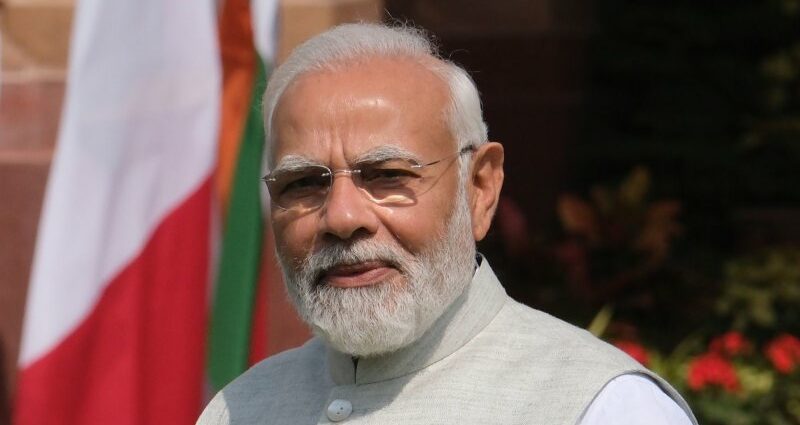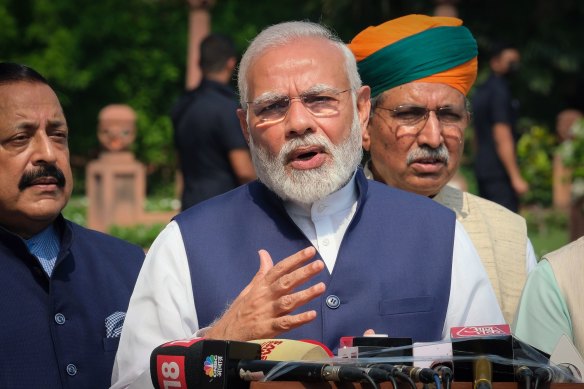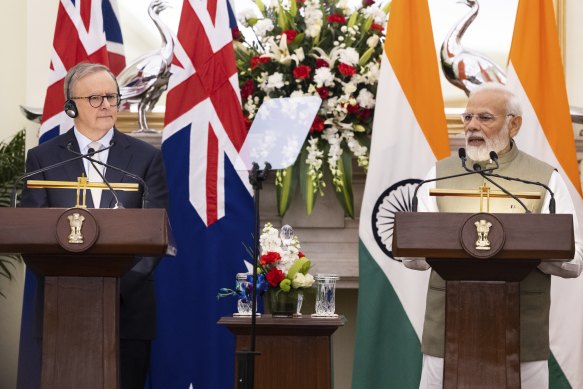Delhi: All over the Indian capital these days loom posters of Narendra Modi, presenting him as the great modernising prime minister pulling India forward. But those posters also hint at the opposite: an emerging personality cult and an authoritarian streak that is dragging India backward.
In immediate political terms, the personality cult perhaps succeeds. With approval ratings at home of about 78 per cent, Modi is far and away the most popular major leader in the world today, according to Morning Consult.
Prime Minister Narendra Modi.Credit:Bloomberg
With the opposition in disarray, Modi is expected to win a third term as prime minister in next year’s elections.
While Modi polls extremely well, many worldly Indians are aghast that he has made India less secular and tolerant, creating what some argue is aHindu nationalism that marginalises religious minorities, particularly Muslims.
And it’s not just marginalisation: Muslims are periodically accused of slaughtering cows, which are sacred to Hindus, and lynched. In a typical case this month, a mob in Bihar state accused a Muslim of carrying beef and beat him to death.
Prime Minister Anthony Albanese and Prime Minister of India Narendra Modi in Delhi, India this month.Credit:Alex Ellinghausen
Modi has presided over a crackdown on news organisations, and Indians have been repeatedly arrested for their tweets. Sweden’s V-Dem Institute, in a new report, listed India not as a democracy but as an “electoral autocracy” ranking 108th among 179 countries in its electoral democracy index.
“It’s very scary what’s happening,” said Bunker Roy, founder of Barefoot College, one of India’s most celebrated rural development initiatives. “I think we’re going into authoritarianism.”
India used to be a correspondent’s dream, echoing with the sound and fury of strongly held opinions. But today people often clam up when I ask about Modi. Reporters Without Borders now ranks India a dismal 150th in press freedom among 180 countries worldwide.
“We work under a cloud of fear,” Anuradha Bhasin, editor of The Kashmir Times, wrote in a brave essay in The New York Times this month.
One lesson of Asia is that economies can thrive under authoritarianism — see the history of South Korea, Taiwan and China — but that religious extremism is more perilous because it can gain momentum, create fissures and suck oxygen from education and economic management. Pakistan went through its own drift to religious zealotry and offers a cautionary tale.
Pakistan was founded by a not particularly observant Muslim, Muhammad Ali Jinnah, who drank alcohol and appointed a member of the (now persecuted) Ahmadi religious minority to be the country’s first foreign minister.
But then, in 1977, General Mohammad Zia ul-Haq seized power and engineered a wave of conservative Muslim nationalism that still tears Pakistan apart.
That would be my nightmare for India, because the fires of religious extremism and grievance are easier to ignite than extinguish. But I honestly don’t think India will tumble that far. I agree with Urmi Basu, a civil society leader from Kolkata, that Indian democracy will get through this, just as it survived a retreat from democracy under Indira Gandhi. India still has a federal system that gives power to the states, and that constrains Modi.
To my eye, Modi’s extraordinary popularity rests not just on demagogy but also on real accomplishments (plus, he’s very good at claiming credit for accomplishments that are less real).
Let’s talk toilets. Millions of Indians still practice open defecation, which spreads disease and parasites. A national survey in 2020-21 was released this month and found that 21 per cent of rural households still had no access to any toilet — but that’s a significant improvement from almost 60 per cent having no access in 2012.
Modi has championed an end to open defecation, which may seem undignified for a politician, but it saves lives.
Modi has also promoted the use of gas cylinders for cooking, rather than burning sticks and cow dung, which smoke up kitchens to dangerous levels. This hugely affects impoverished women, for some 600,000 Indians die annually from this indoor air pollution.
Construction of ports and roads has improved, and Modi has pushed a digital identification and payment system that brings villagers into the banking system. Modi isn’t the primary reason for this technological marvel, but he presided over its expansion.
“Even his detractors admit he is very good at economic development and infrastructure projects,” said Alyssa Ayres, an India scholar and dean at George Washington University. Ayres said that during Modi’s first years as prime minister, he was less polarising and leaned in on development.
More recently, the authoritarian streak has become more prominent.
Modi is now to all of India what he was for many years as the boss of the state of Gujarat. There, he was a pro-business leader who oversaw strong economic growth, but his record was badly damaged by a pogrom against Muslims on his watch in 2002; there is disagreement about his degree of complicity, but he certainly mismanaged it.
Looking ahead, what I fear is that the authoritarian, Hindu nationalist Modi is eclipsing the economy-boosting, toilet-building Modi.
To imagine a worst case, just look next door at the sad shambles of today’s Pakistan.
This article originally appeared in The New York Times.
Get a note directly from our foreign correspondents on what’s making headlines around the world. Sign up for the weekly What in the World newsletter here.
Most Viewed in World
From our partners
Source: Read Full Article
-
NatWest boss Alison Rose says sorry over Nigel Farage 'de-banking' row
-
FL teen killed in crash after posting about never being in an accident
-
UK heatwave to return in days as maps show scorching weather
-
Judge rules Mike Pence must TESTIFY in Trump election overturn probe
-
Desperate plea over Pat Butcher sex shop painting mistakenly sold for £19



